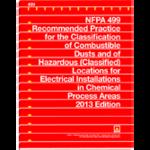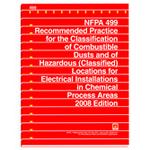
NFPA (Fire) 499
- Comments Off on NFPA (Fire) 499
- NFPA-FIRE
Product Details
- Published:
- 04/23/2023
- ANSI:
- ANSI Approved
- Number of Pages:
- 41
- Note:
- This product is unavailable in Ukraine, Russia, Belarus





Codes and standards published by NFPA are displayed as read-only under license from NFPA solely for use within this system. NFPA material may not be downloaded, printed, reproduced, or transferred.
Help ensure you and your team have the most current knowledge on selecting and installing electrical systems and equipment for safe use in locations classified as hazardous with NFPA 499, 2021 edition.
The presence of combustible dusts in industrial settings where electrical systems and equipment are used represents a significant ignition hazard. NFPA 499, Recommended Practice for the Classification of Combustible Dusts and of Hazardous (Classified) Locations for Electrical Installations in Chemical Process Areas, provides guidance for selecting electrical systems for safe use in Class II hazardous (classified) locations in accordance with relevant codes and standards.
This essential safety document delivers criteria for designating classified areas where combustible dusts are produced, processed, or handled. NFPA 499 is a must-have for:
The 2021 edition is updated for consistency with NFPA 70®, National Electrical Code®, 2020 edition, and the latest accepted practices in the chemical process industries.
This recommended practice offers detailed guidelines, classification diagrams, and dust group classifications on an extensive list of combustible dusts.
Revisions to the 2021 edition include:
Help safeguard lives and property in the industrial workplace by complying with NFPA 499, Recommended Practice for the Classification of Combustible Dusts and of Hazardous (Classified) Locations for Electrical Installations in Chemical Process Areas.
Stay on top of safety by ordering your copy of the 2021 edition today.




Click here to purchase
Use the latest criteria in the 2013 edition of NFPA 499 to determine electrical classification for combustible dust hazards so you can properly select and install electrical systems and equipment for safe use in Class II hazardous (classified) locations.
NFPA 499: Classification of Combustible Dusts and of Hazardous Locations for Electrical Installations in Chemical Process Areas contains detailed guidelines and diagrams that are useful tools for professionals who perform hazardous (classified) area classification as specified by NFPA 70: National Electrical Code for the purpose of selecting and installing electrical equipment that will not be an ignition source in environments where combustible dusts are produced, processed, or handled. This Recommended Practice also provides extensive data on physical properties of selected combustible dusts, including specific Class II, Division, and dust group information.
Major changes to the 2013 NFPA 499:
Additional changes in NFPA 499 improve usability and consistency with other documents.
The 2013 NFPA 499 is a valuable on-the-job tool for facility operators and installers and maintainers of industrial equipment using electrical power that is to be located in or near areas where combustible dusts are produced, used, or handled; equipment manufacturers providing equipment suitable for use in such electrically classified areas; design engineers/consultants; loss prevention or safety engineers; insurance professionals; enforcing officials; and owner/operators of industrial facilities.




Click here to purchase
This Recommended Practice is a vital first step for the selection of electrical systems and equipment for safe use in Class II hazardous (classified) locations in accordance with the NEC®.
Up-to-date with NFPA 70®: National Electrical Code®, the 2017 edition of NFPA 499: Classification of Combustible Dusts and of Hazardous (Classified) Locations for Electrical Installations in Chemical Process Areas presents criteria to determine ignitability hazards in chemical process areas where combustible dusts are produced, processed, or handled.
Make sure you can properly select and install electrical systems and equipment for safe use in Class II hazardous (classified) locations.
Filled with detailed guidelines and diagrams, NFPA 499 also provides extensive data on physical properties of selected combustible dusts, including specific Class II, Division, and dust group information.
The 2017 edition of NFPA 499 is revised for:
It’s an important tool for anyone who performs hazardous (classified) area classification.
NFPA 499 is used by facility operators and installers and maintainers of industrial equipment using electrical power that is to be located in or near areas where combustible dusts are produced, used, or handled; equipment manufacturers providing equipment suitable for use in such electrically classified areas; design engineers/consultants; and loss prevention or safety engineers. Insurance professionals, enforcing officials, and owner/operators of industrial facilities also need to stay up-to-date with the latest edition.




Before installing electrical equipment, accurate hazardous area classification is essential!
Determine the need for, and extent of, Class II (combustible dusts), Division area classification using this up-to-date Recommended Practice. With a specific focus on chemical manufacturing facilities, NFPA 499 contains detailed guidelines and diagrams that serve as useful tool for professionals who perform hazardous (classified) area classification for the purpose of selecting and installing electrical equipment that will not be an ignition source in environments where combustible dusts are produced, processed, or handled.
This document also provides extensive data on physical properties of selected materials, including specific Class II, Division dust group information. In the 2004 edition, definitions of hazardous (classified) locations parallel with the National Electrical Code®. Up-to-date with NFPA’s Manual of Style.



